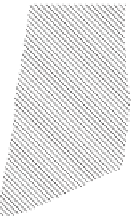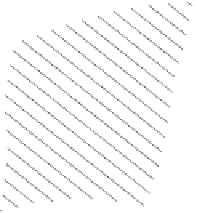Geology Reference
In-Depth Information
Array
P
2
P
1
C
15
Chargeability
a
= 244m
a
= 122m
a
= 61m
a
a
Station
10
x
x
ms
x
x
x
x
x
x
x
5
x
x
x
x
x
x
x
x
x
x
x
0
Resistivity
500
250
0
x
x
x
Ω
m
x
x
x
x
x
x
x
x
x
x
x
x
x
x
x
x
0
100m
1
1
1
Drill hole
>0.50% Cu <0.50% Cu
Overburden
Bethsaida
granodiorite
Skeena quartz
diorite
Mineralized
Skeena quartz
diorite - pyrite,
chalcopyrite,
bornite
1
1
2
Fault
1
2
1
Fig. 8.35
Time domain induced polarisation and
resistivity profiles over a copper porphyry body in
British Columbia, Canada. (After Seigel 1967.)
netic interpretation because dipole fields are involved
in both cases. It is thus possible to calculate the poten-
tial distributions around polarized bodies of simple
shape such as spheres, ellipsoids and inclined sheets
(Sundararajan
et al
. 1998) by making assumptions about
the distribution of charge over their surfaces.
Most interpretation, however, is qualitative. The
anomaly minimum is assumed to occur directly over
the anomalous body, although it may be displaced
downhill in areas of steep topography.The anomaly half-
width provides a rough estimate of depth.The symmetry
or asymmetry of the anomaly provides information
on the attitude of the body, the steep slope and positive
tail of the anomaly lying on the downdip side.
The type of overburden can have a pronounced effect
on the presence or absence of SP anomalies. Sand has
little effect but a clay cover can mask the SP anomaly of
an underlying body.
The SP method is only of minor importance in explo-
ration.This is because quantitative interpretation is diffi-
cult and the depth of penetration is limited to about
30 m. It is, however, a rapid and cheap method requiring
only simple field equipment. Consequently, it can be
useful in rapid ground reconnaissance for base metal de-
Surface
-
Water
table
Current
flow
+
Negative ions
Fig. 8.36
The mechanism of self-potential anomalies. (After Sato
& Mooney 1960.)
Station spacing is generally less than 30 m. Traverses
may be performed by leapfrogging successive electrodes
or, more commonly, by fixing one electrode in barren
ground and moving the other over the survey area.
8.4.4 Interpretation of self-potential
anomalies
The interpretation of SP anomalies is similar to mag-





































































































